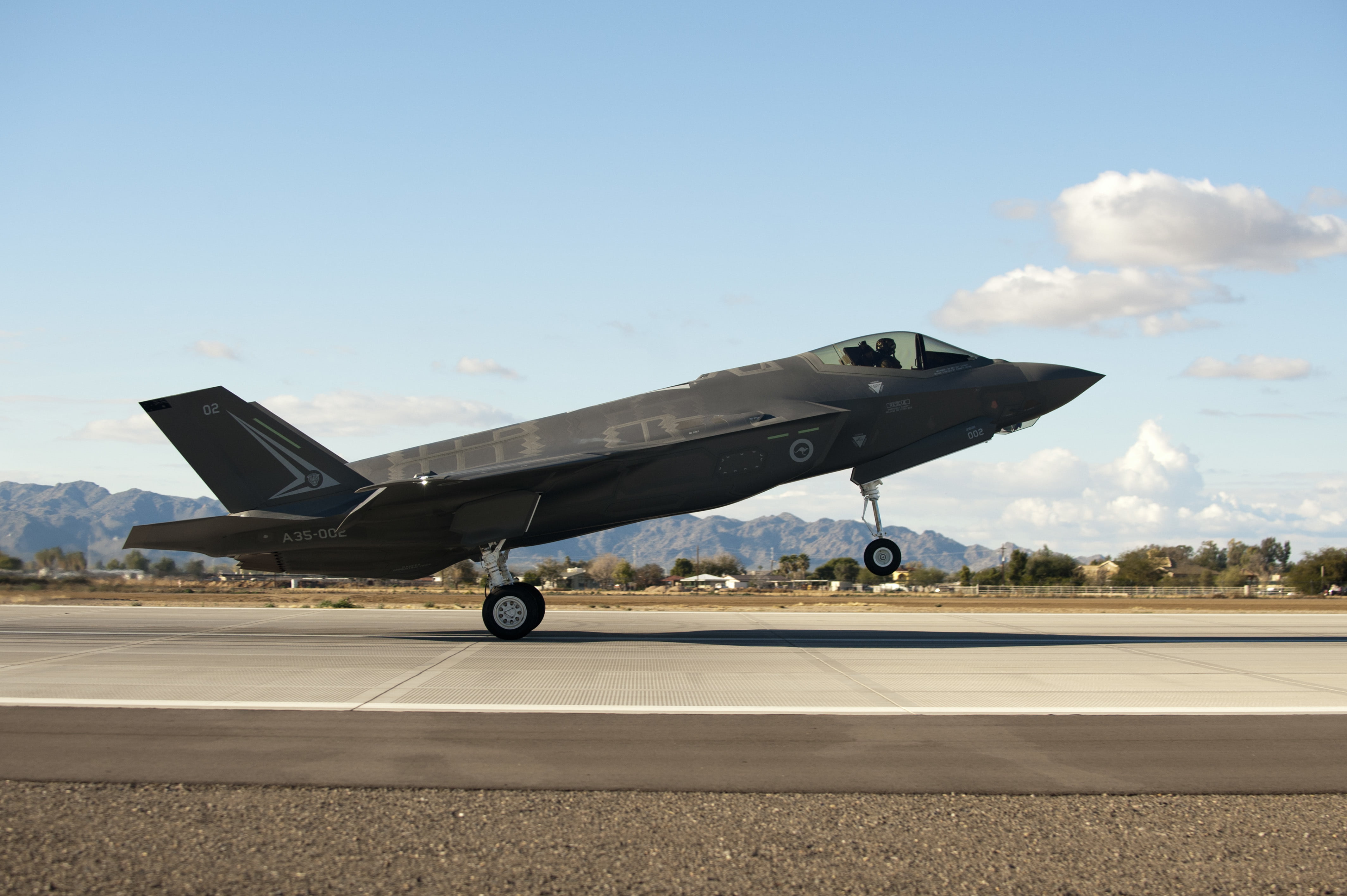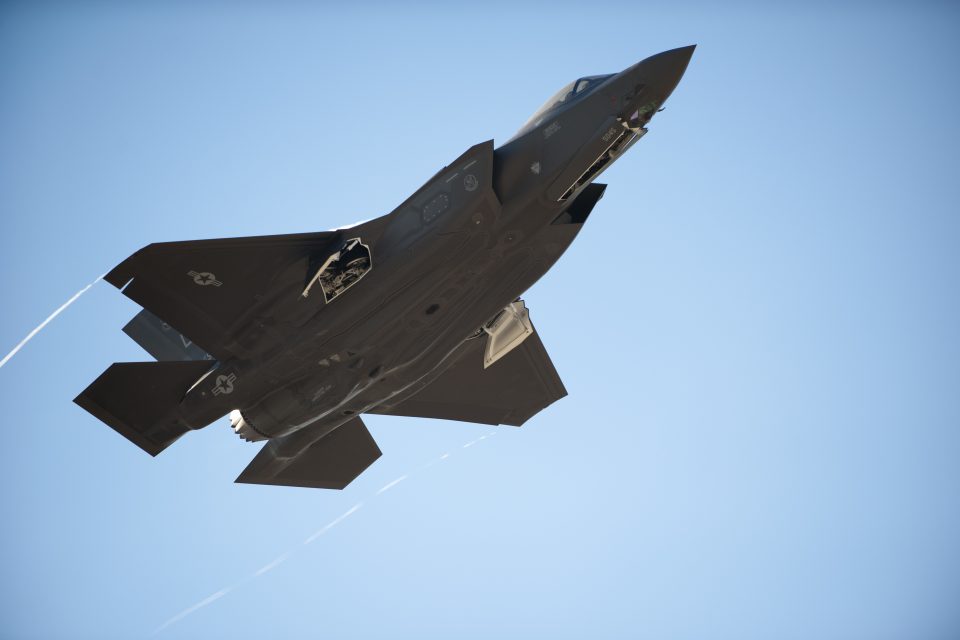2014-12-19 The first RAAF F-35A has arrived at Luke AFB, and opens up the international training side of Luke AFB.
Luke AFB is to be the center of excellence for the US and the allies in training to use the F-35A and to shaping integration of the aircraft as well.
The F-35 is not just about interoperability; it is about the capability of operating as an integrated force.
The first photo shows the first Royal Australian Air Force F-35A Lightning II jet arrived at Luke Air Force Base Dec. 18, 2014.
The jet’s arrival marks the first international partner F-35 to arrive for training at Luke.
The second photo shows the 17th USAF Luke Air Force Base F-35A Lightning II jet arriving at Luke Air Force Base Dec. 18, 2014. The jet accompanied the first Royal Australian Air Force F-35A Lightning II to arrive here.
56th Fighter Wing Public Affairs
12/18/14
In a story by 2nd Lt. Tanya Wren, 56th Fighter Wing Public Affairs, published on December 18, 2014:
2/18/2014 – LUKE AIR FORCE BASE, Arizona — The first Royal Australian Air Force F-35A Lightning II jet arrived at Luke Air Force Base December 18. The jet’s arrival marks the first international partner F-35 to arrive for training at Luke.
“Today, we take another tremendous step forward in our transition to the F-35 here at Luke,” said Brig. Gen. Scott Pleus, 56th Fighter Wing commander. “Australia is the first of 10 nations that will not only become part of the Luke community, but will share in calling the West Valley a home away from home.”
Nine other nations will be training alongside the United States on the new airframe. Other partner-nations that will be joining the U.S. and Australia in the F-35A training program here will be Turkey, Italy, Norway, and the Netherlands, in addition to Foreign Military Sales countries Japan, Korea and Israel.
“Welcoming our first Australian F-35 is a special day for Luke and the community that has been so supportive of us,” Pleus said.
“The Royal Australian Air Force is delighted to be the first foreign partner nation with F-35A aircraft arriving at Luke Air Force Base,” Air Commodore Gary Martin, air attaché said. “This is an important milestone for Australia and we are looking forward to the commencement of our fifth-generation pilot training here at Luke in 2015.”
Luke will be the central training hub for international F-35A training. In the near future, international and U.S. students will be teamed together learning how to effectively employ the fifth-generation strike fighter.
“Luke’s mission has been to train the world’s greatest fighter pilots,” Pleus said. “We will continue on that legacy as we train the world’s best F-35A pilots.”
The teamwork on the F-35 isn’t the first time Luke has worked with international partners on an airframe. Luke’s Airmen currently train on base alongside pilots and maintainers from Singapore and Taiwan on the F-16.
Teaming up on the F-35 is another opportunity for Luke Airmen and pilots and maintainers from other nations to learn from one another.
“The collaborative training we’ll be doing here on aircraft designed with stealth, maneuverability and integrated avionics will better prepare our combined forces to assume multi-role missions for the future of strike aviation,” Pleus said. “From the bed-down of the F-35 and its infrastructure to the execution of training, our partner-nations have been an important piece of Luke’s F-35 team. The relationships we’re building now will be invaluable when we deploy together around the world protecting our respective countries.”
Australia’s training will be conducted in conjunction with the 61st Fighter Squadron. The 62nd Fighter Squadron is expected to stand-up in June, to be joined by partner-nations Italy and Norway. Flight operations for the 62nd are scheduled to begin in September of 2015.
Luke AFB will be the center of excellence for USAF and allied training with regard to the F-35A.
As Art Cameron, the Lockheed Martin site Director for the F-35 at Luke AFB, and as a young USAF maintainer was part of the team which stood up the first F-16s at Hill AFB, commented:
Question: With regard to training, how will the partners and the USAF work together?
Cameron: The partners which includes the US Air Force will train on the same ramp flying out of six different squadrons.
Each Air Force squadron will have 24 airplanes, which will mean that 144 F-35s will be operating here when the aircraft build up is completed.
Question: This will enable significant cross learning between the USAF and international pilots? (not maintainers)
Cameron: It will. The squadrons will be joint squadrons with multiple partners flying in each squadron.
And each country can fly the other country’s jets.
Pilots will be able to brief and step up to any airplane inside that squadron.
In other words, Italian, Australian or Norwegian pilots will fly USAF planes and vice versa.
Question: That’s a significant step forward in changing the mental furniture of what these folks are prepared to do. How important then is the pooling of training?
Cameron: So, this is the second role for Luke AFB.
Luke, because of the multiple countries present, will serve as the battle lab for interoperability.
It will be central to reworking coalition operations in the future.
The F-35 is a key element of shaping the future interoperability piece and we are doing proof of concept here at Luke AFB.
And it is clearly not going to be a one way street.
The US will learn a great deal from its coalition partners.
The RAAF is already working some cutting edge thinking about how to transform its force with the inclusion of the F-35 as a driving force.
John Blackburn (Air Marshal Blackburn retired as Deputy Chief of Air Force) who is now the Deputy Chairman of the influential Australian think tank, the Kokoda Foundation (as of January 2015 it will be called the Institute for Regional Security) and Deputy Chair at the Williams Foundation commented on the way ahead:
When Australia buys a system, it generally looks at the parent service, which has developed and deployed them.
This means the RAAF has a close relationship with the USN, with the Super Hornets, the Growlers and the P-8s to come.
With the coming of the F-35A the RAAF will work with the USAF and train at Luke AFB.
I expect that the RAAF will initially use the Growlers in a similar way to the USN does; however, as they gain experience I expect that new ways of integrating the Growlers, Super Hornets and JSFs will be developed.
These changes may in turn influence how the US Forces use their range of capabilities.
In perhaps a unique fashion we’re at the intersection of a set of relationships with U.S. Navy, the U.S. Air Force, the Marines.
This relationship is especially strong at the operator level where the innovations are clearly going to occur.
We will clearly tap into the US and allied F-35 community to drive change on how to integrate that change with overall force transformation.
For an overview on RAAF modernization and where the F-35 fits it see the following:
The video above was published earlier this year:
The Government has approved the acquisition of an additional 58 F-35 Lightning II Joint Strike Fighter aircraft.
The fifth generation F-35 is the most advanced fighter in production anywhere in the world and will make a vital contribution to our national security.
Together with the Super Hornet and Growler electronic warfare aircraft, the F-35 aircraft will ensure Australia maintains a regional air combat edge.
The F-35 will also provide a major boost to the ADF’s intelligence, surveillance and reconnaissance capabilities.
The first F-35 aircraft will arrive in Australia in 2018 and enter service with the Royal Australian Air Force in 2020. Australia has been working with the United States as a partner in the Joint Strike Fighter programme since the Coalition joined in 2002.
Acquiring F-35 aircraft will reinforce the ADF’s ability to operate seamlessly with US forces and Australia’s capacity to continue supporting our shared strategic interests under the US alliance.
The acquisition of F-35 aircraft will bring significant economic benefits to Australia, including in regional areas and for the local defence industry with more jobs and production for many locally-based skilled and technical manufacturers. The total capital cost of $12.4 billion for this acquisition includes the cost of associated facilities, weapons and training.
Around $1.6 billion in new facilities and infrastructure will be constructed, including at RAAF Base Williamtown in New South Wales and RAAF Base Tindal in the Northern Territory.



